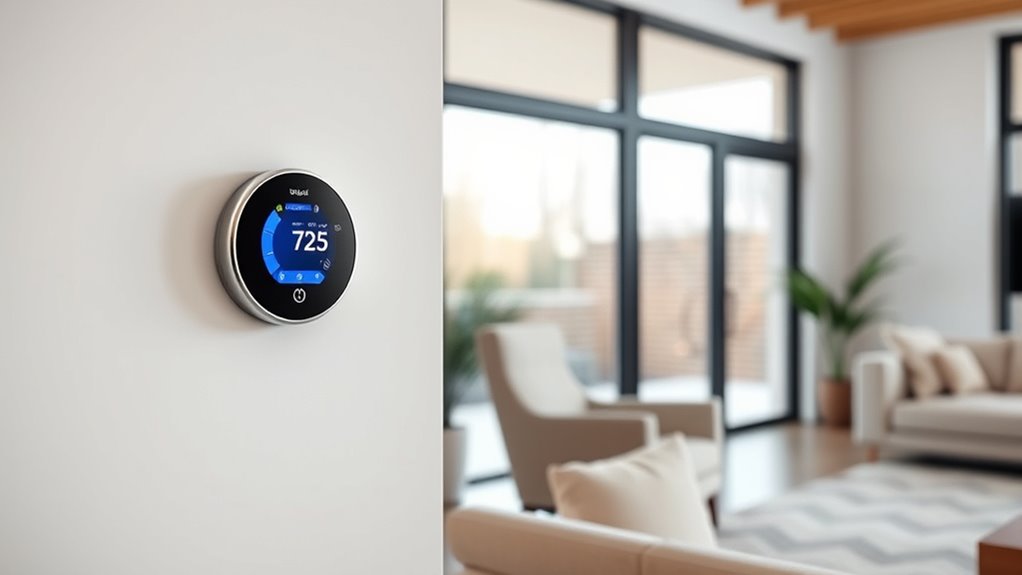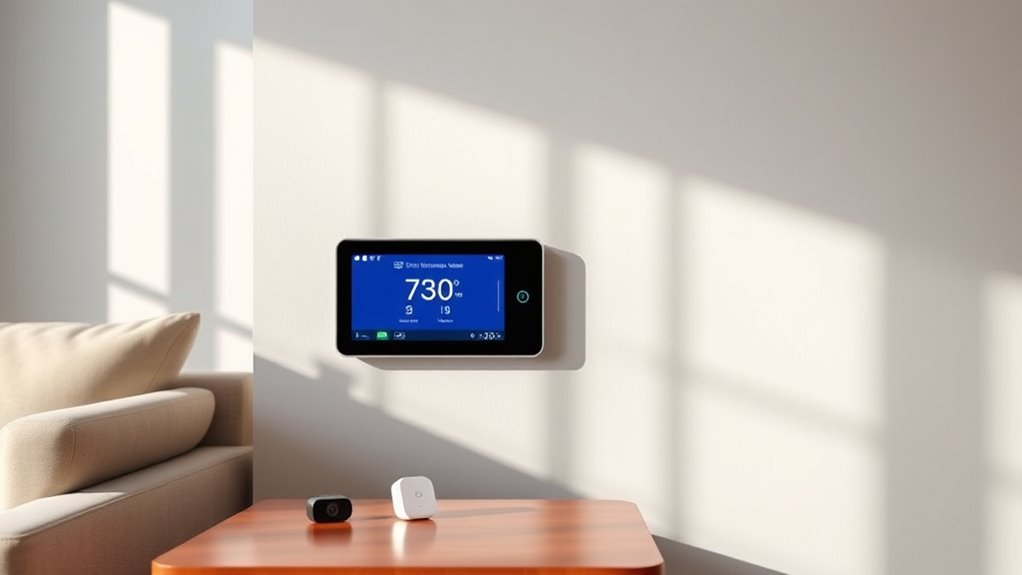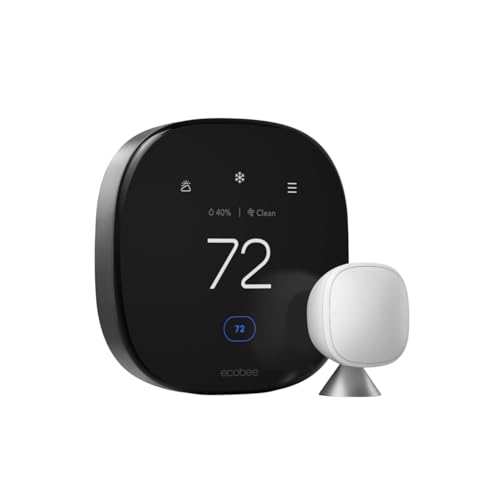If you’re looking for the best smart thermostats with remote sensors to boost comfort and cut energy costs, I’ve got you covered. These devices, like the ecobee Smart Thermostat Premium and T9 WiFi models, offer precise control over multiple rooms, smart features, and easy installation. They work with popular voice assistants and fit various HVAC systems. Keep exploring to find the perfect setup for your home’s climate and efficiency needs.
Key Takeaways
- Remote sensors enable multi-room temperature and occupancy monitoring, improving overall comfort and energy efficiency.
- Top smart thermostats offer seamless integration with popular smart home ecosystems like Alexa, Google, and Apple HomeKit.
- Installation is straightforward for most models, with options for wall-mount or tabletop placement, and some may require professional setup.
- Features like adaptive scheduling, geofencing, and energy reports help optimize HVAC use and maximize savings.
- Advanced air quality monitoring and safety alerts enhance indoor environment quality and occupant safety.
ecobee Smart Thermostat Premium with Sensor and Air Quality Monitor
If you’re looking for a smart thermostat that combines energy savings with advanced air quality monitoring, the ecobee Smart Thermostat Premium with Sensor and Air Quality Monitor is an excellent choice. It can save you up to 26% annually on heating and cooling costs and is ENERGY STAR certified. The included SmartSensor adjusts temperature in key rooms, reducing hot and cold spots. It also monitors indoor air quality, alerts you to poor conditions, and reminds you to change filters. Built-in smoke detection adds safety, while occupancy sensing and security alerts help protect your home. Plus, its sleek design, vibrant display, and voice control make it both functional and stylish.
Best For: homeowners seeking an energy-efficient smart thermostat with advanced air quality monitoring, home security features, and voice control integration.
Pros:
- Saves up to 26% annually on heating and cooling costs, helping reduce energy bills.
- Built-in air quality monitor and safety features like smoke detection and air filter reminders for healthier indoor environments.
- Compatible with most 24VAC HVAC systems and offers easy installation with the Power Extender Kit.
Cons:
- Requires a subscription to ecobee Smart Security for full security functionalities.
- Needs an Apple Home Hub to enable Siri voice control, adding extra setup requirements.
- Premium features and device may come at a higher initial cost compared to basic thermostats.
T9 WiFi Smart Thermostat with 1 Smart Room Sensor
The T9 WiFi Smart Thermostat with 1 Smart Room Sensor is an excellent choice for homeowners seeking precise, room-specific comfort and energy savings. This ENERGY STAR certified thermostat allows remote control via a mobile app and offers Auto Home/Away Scheduling to automatically adjust temperatures. It supports various heating systems, including forced air, hot water, and heat pumps, with a simple DIY installation using a included power adapter. The smart sensor detects occupancy up to 200 feet, enabling targeted comfort in specific rooms like bedrooms. Compatible with Alexa, Google Assistant, and Apple HomeKit, it provides intuitive control and helps maximize energy efficiency effortlessly.
Best For: homeowners seeking precise room-by-room temperature control and energy savings with easy DIY installation.
Pros:
- ENERGY STAR certified for energy efficiency and potential rebates
- Supports multiple heating systems and voice assistant integration
- Easy DIY setup with included power adapter and remote control via mobile app
Cons:
- Not compatible with electric baseboard heating (120-240V)
- Requires a C-wire for installation, which may not be available in all homes
- Limited to one smart sensor included; additional sensors may be needed for multi-room focus
RCHTSENSOR-1PK, Smart Room Sensor works with T9/T10 WIFI Smart Thermostats
The RCHTSENSOR-1PK Smart Room Sensor is an excellent choice for homeowners seeking to optimize their comfort with the T9 or T10 Wi-Fi smart thermostats, especially in multi-room setups. It’s compatible with Series 3 and Series 4 T9 models, making installation straightforward—just insert the included batteries and pair via the Resideo app in under 10 minutes. The sensor measures temperature, humidity, and detects motion to focus on occupied rooms. It helps maintain consistent, comfortable temperatures by adjusting heating or cooling based on real-time room conditions. Its flexible placement options, like wall-mounting or tabletop use, make it a versatile addition to your smart home ecosystem.
Best For: homeowners seeking an easy-to-install smart room sensor to enhance multi-room climate control with T9 or T10 Wi-Fi smart thermostats.
Pros:
- Simple installation with no tools required, just insert batteries and pair via the Resideo app
- Measures temperature, humidity, and detects motion to optimize comfort in occupied rooms
- Versatile placement options include wall-mounting and tabletop use for flexible setup
Cons:
- Motion detection may not recognize still occupancy, such as sleep or desk work
- Compatibility issues may arise with older or newer thermostats, requiring customer support or replacements
- Readings can sometimes be slightly higher than actual room temperature, around 74°F when set to 70°F
Sensi Touch 2 Smart Thermostat with Touchscreen
For homeowners seeking a sleek, user-friendly thermostat that combines modern touchscreen control with smart features, the Sensi Touch 2 stands out. Its vibrant color display, programmable settings, and Wi-Fi connectivity make managing your home’s comfort effortless. Compatible with Sensi Room Sensors (sold separately), it helps balance temperatures across rooms for consistent comfort. Easy to install with a simple DIY setup, it works with most HVAC systems requiring a c-wire. Plus, it offers energy savings of around 23%, remote access, and performance alerts, all while prioritizing your privacy. With Alexa compatibility and a trusted 100-year heritage, it’s a smart choice for modern homes.
Best For: homeowners seeking an easy-to-use, modern touchscreen thermostat with smart features and energy-saving capabilities.
Pros:
- Vibrant color touchscreen display for intuitive control
- Easy DIY installation with universal Bluetooth setup technology
- Compatible with Alexa for voice control and Sensi Room Sensors for enhanced temperature management
Cons:
- Requires a common wire (c-wire) for installation in most systems
- Sensi Room Sensors are sold separately, adding to overall cost
- Limited detailed customization options compared to more advanced smart thermostats
Sensi Smart Thermostat with Wi-Fi and Alexa Compatibility
If you’re looking for a smart thermostat that combines easy DIY installation with seamless compatibility, the Sensi Smart Thermostat with Wi-Fi and Alexa is an excellent choice. I appreciate its straightforward setup, thanks to the built-in level and step-by-step app instructions, often eliminating the need for a common wire. It fits well into existing wall space, resembling traditional thermostats. With Wi-Fi connectivity and Alexa compatibility, I can control my home’s temperature remotely and integrate it with my smart home system. Plus, it’s ENERGY STAR certified, helping me save about 23% on energy costs while providing detailed usage reports and maintenance alerts.
Best For: homeowners seeking an easy-to-install, energy-efficient smart thermostat with remote control and smart home integration.
Pros:
- Easy DIY installation with built-in level and step-by-step app instructions
- Compatible with most HVAC systems, often eliminating the need for a common wire
- ENERGY STAR certified, helping save approximately 23% on HVAC energy costs
Cons:
- May not be compatible with very old or specialized HVAC systems
- Requires Wi-Fi connection for remote features and updates
- Limited advanced customization options compared to more complex smart thermostats
Smart WiFi Thermostat with Room Sensor and Touchscreen
A smart WiFi thermostat with a room sensor and touchscreen is ideal for homeowners seeking precise temperature control and easy management. It supports over 95% of 24VAC HVAC systems, making installation straightforward with its self-test compatibility guide. The thermostat works with the Provirtec smart thermo-hygrometer for real-time home monitoring and uses body location-based detection for accurate comfort and energy savings. It offers three modes—Sleep, Home, and Away—that automatically optimize temperature settings. The large 3.95-inch touchscreen and intuitive controls simplify adjustments, while WiFi and BT Mesh ensure stable connectivity. App control and programmable features further enhance convenience and efficiency.
Best For: homeowners seeking precise, customizable temperature control with easy app management and compatibility with most 24VAC HVAC systems.
Pros:
- Supports over 95% of 24VAC HVAC systems, ensuring broad compatibility and easy installation.
- Features a large touchscreen and intuitive controls suitable for users of all ages.
- Includes a room sensor for enhanced temperature accuracy and energy efficiency.
Cons:
- Requires a C-wire for installation, which may not be present in all homes.
- WiFi connectivity depends on network stability; disruptions may affect remote control.
- Firmware updates and full app functionality require a Wi-Fi connection.
Google Nest Learning Thermostat (4th Gen, 2024) with Nest Temperature Sensor
The Google Nest Learning Thermostat (4th Gen, 2024) with Nest Temperature Sensor stands out as an ideal choice for homeowners seeking a sleek, intelligent thermostat that adapts to their routines. Its polished Obsidian finish and modern round design make it a stylish addition to any home. The large, adjustable touchscreen with Dynamic Farsight ensures clear visibility from across the room. Easy to install and compatible with most 24V systems—often without a C-wire—it offers quick setup. With smart features like remote control via the Google Home app, voice compatibility, and the ability to place sensors in different rooms, it maximizes comfort while conserving energy.
Best For: homeowners seeking a stylish, energy-efficient smart thermostat that seamlessly integrates with smart home systems and adapts to their routines.
Pros:
- Sleek, modern design with a polished Obsidian finish and adjustable large touchscreen display.
- Easy installation compatible with most 24V systems, often without needing a C-wire.
- Advanced learning algorithms and remote control features that enhance comfort and energy savings.
Cons:
- Higher price point compared to basic thermostats, which may be a barrier for some users.
- Some users report a learning curve during initial setup and configuration.
- Dependence on Wi-Fi connection; performance may be affected by connectivity issues.
Amazon Smart Thermostat
Looking for an affordable smart thermostat that seamlessly integrates with your Alexa devices? The Amazon Smart Thermostat (2021 first generation) is a great choice. It’s compatible with most 24V HVAC systems, including force air, heat pumps, and radiant boilers, but not suitable for 110-240V systems. Easy to install with a C-wire or power adapter, it offers features like Alexa control, on-device buttons, and app management. It supports automated temperature adjustments, scheduling, and energy-saving modes. Certified ENERGY STAR, it can save around $50 annually on energy bills. Overall, it’s a budget-friendly, reliable option for smart, convenient home climate control.
Best For: homeowners seeking an affordable, easy-to-install smart thermostat that integrates seamlessly with Alexa and offers energy savings.
Pros:
- Compatible with most 24V HVAC systems, including force air, heat pumps, and radiant boilers
- Easy DIY installation with guided setup via the Alexa app
- Supports automation features like scheduling, presence detection, and energy monitoring
Cons:
- Not suitable for 110-240V systems such as electric baseboard heat
- Some Android users report app stability issues during scheduling
- Requires a C-wire or power adapter for installation, which may involve additional wiring or cost
ecobee Smart Thermostat Essential, Wi-Fi Programmable Thermostat
If you want a budget-friendly smart thermostat that still offers reliable energy savings and easy control, the ecobee Smart Thermostat Essential is an excellent choice. It can save you up to 23% annually by adjusting your schedule automatically, conserving energy when you’re away and boosting comfort when you’re home. The setup is straightforward, even without a C-wire—just use the Power Extender Kit. Its color touchscreen makes temperature adjustments simple, and you can control it remotely through the ecobee app. Plus, it works seamlessly with Apple HomeKit, Google Assistant, and Alexa, integrating smoothly into your smart home ecosystem.
Best For: budget-conscious homeowners seeking reliable energy savings and easy smart thermostat integration without the need for complex wiring.
Pros:
- Saves up to 23% annually on heating and cooling costs through personalized scheduling
- Easy DIY installation with no C-wire required using the Power Extender Kit
- Compatible with popular smart home platforms like Apple HomeKit, Google Assistant, and Alexa
Cons:
- Limited to 85% system compatibility; some HVAC systems may not be supported
- Lacks advanced features found in higher-end ecobee models, such as room sensors
- The color touchscreen, while user-friendly, may be less customizable compared to premium models
T9 WiFi Smart Thermostat with Room Sensor and Touchscreen Display
For homeowners seeking precise temperature control across multiple rooms, the T9 WiFi Smart Thermostat with Room Sensor and Touchscreen Display stands out as a top choice. It offers an intuitive touchscreen interface and compatibility with Alexa and Google Assistant, making voice control easy. Designed for most heat and cool systems, it includes a power adapter for simplified installation. The thermostat uses smart room sensors (sold separately) to focus comfort where it’s needed most. Features like adaptive scheduling, energy reports, and geofencing help optimize efficiency and savings. Plus, connecting with utility programs can earn seasonal rewards, making it a smart, sustainable choice for modern homes.
Best For: homeowners seeking precise, multi-room temperature control with smart features and energy efficiency integration.
Pros:
- Compatible with most heat/cool systems and includes a power adapter for easy installation
- Supports smart room sensors for targeted comfort and multi-room management
- Integrates with Alexa and Google Assistant for voice control and offers energy reports and adaptive scheduling for savings
Cons:
- Not compatible with electric baseboard heating systems (120-240V)
- Smart room sensors are sold separately, increasing overall cost for multi-room control
- Requires WiFi connectivity, which may be a limitation in areas with poor internet access
Google Nest Thermostat E Bundle
The Google Nest Thermostat E Bundle is an excellent choice for homeowners seeking an energy-efficient and easy-to-control smart thermostat. It learns your preferred temperatures and automatically adjusts to save energy while keeping your home comfortable. The thermostat displays a Nest Leaf when you select energy-saving settings and offers energy usage insights via the app. Compatible with various systems, it uses the Google Nest Temperature Sensor to monitor specific rooms and adjust accordingly. With Home/Away Assist, it automatically sets Eco Temperatures when you’re away, saving energy. Remote control through the app makes it simple to manage your home’s climate from anywhere.
Best For: homeowners seeking an energy-efficient, easy-to-use smart thermostat that learns their preferences and offers remote control capabilities.
Pros:
- Learns your preferred temperatures and adjusts automatically to optimize energy savings and comfort
- Compatible with a wide range of heating and cooling systems, including zoned and district heating setups
- Provides energy usage insights via the app and allows remote adjustments from anywhere
Cons:
- Installation may be challenging for some users, despite being designed for easy setup
- Limited to heating-only systems in certain configurations, such as heat pumps
- The display is less feature-rich compared to higher-end smart thermostats with larger screens
ecobee Smart Thermostat Enhanced
Designed for homeowners seeking both energy efficiency and precise climate control, the ecobee Smart Thermostat Enhanced stands out with its advanced sensors and robust smart home integration. It can save up to 26% annually on heating and cooling costs by automatically adjusting temperatures when you’re away and preheating or precooling before you arrive. The thermostat considers humidity to keep your environment comfortable. It works seamlessly with Siri, Alexa, Google Assistant, and most HVAC systems, including heat pumps and boilers. Easy to install with the Power Extender Kit, it’s a reliable, Energy Star-certified choice for optimizing comfort and efficiency through smart control.
Best For: homeowners seeking to optimize energy savings and maintain precise, comfortable climate control with seamless smart home integration.
Pros:
- Saves up to 26% annually on heating and cooling costs through automated adjustments.
- Compatible with a wide range of HVAC systems and smart home platforms, including Siri, Alexa, and Google Assistant.
- Easy to install with included Power Extender Kit, suitable for homes without C-Wire, and features advanced sensors for room-specific climate management.
Cons:
- Requires a compatible HVAC system and may need professional installation for some setups.
- Advanced features and smart sensors may involve additional costs beyond the base thermostat.
- Limited to homes with 24 VAC systems; not suitable for all types of heating and cooling setups.
MOES Smart Programmable Thermostat with Remote Sensor and C-Wire Adapter
If you want a smart thermostat that offers flexible scheduling and reliable remote sensing, the MOES Smart Programmable Thermostat is a solid choice. It supports 7-day programming with 4 modes and works with various heating sources, including gas, electric, and steam. The device connects via Wi-Fi and can be controlled through the Tuya/Smart Life app or voice commands with Alexa and Google Assistant. It includes a zone remote sensor, a C-wire adapter, and can be mounted on walls or tables. While setup can be tricky, it’s designed to improve energy efficiency by over 23% and offers precise temperature regulation.
Best For: homeowners seeking a versatile, Wi-Fi-enabled smart thermostat with customizable scheduling and reliable remote sensing for various heating systems.
Pros:
- Supports 7-day scheduling with 4 modes for flexible programming
- Compatible with multiple heat sources including gas, electric, and steam systems
- Includes remote sensor and C-wire adapter for easier installation and enhanced accuracy
Cons:
- Setup can be complex, especially Wi-Fi connection and initial calibration
- Some users experience software stability issues and temperature inaccuracies
- Lacks built-in fan mode scheduling, requiring manual routines for fan control
MoesGo Programmable WiFi Smart Thermostat with C-Wire Adapter
For homeowners with conventional or heat pump HVAC systems who want to optimize energy savings and comfort, the MoesGo Programmable WiFi Smart Thermostat with C-Wire Adapter is an excellent choice. It supports both system types and offers a 7-day programmable schedule with four modes, automatically adjusting temperatures based on your preferences. The thermostat saves over 23% energy and includes a free temperature sensor that monitors indoor conditions based on presence and scheduled times. It connects via 2.4GHz WiFi and supports voice commands through Alexa and Google Assistant. Keep in mind, it’s not suitable for heating-only or high-voltage systems, and it requires a C-wire or compatible adapter for installation.
Best For: homeowners with conventional or heat pump HVAC systems seeking energy savings, remote control, and smart scheduling.
Pros:
- Supports both conventional (2H/2C) and heat pump (4H/2C) systems for versatile installation
- Saves over 23% energy while providing customizable 7-day schedules and modes
- Includes a free temperature sensor for enhanced indoor climate monitoring and control
Cons:
- Not compatible with heating-only systems lacking a C-wire or high-voltage systems (120V-240V)
- Requires a C-wire or compatible adapter for proper installation
- Connects only over 2.4GHz WiFi, limiting network flexibility
LEVOIT Smart Thermostat with WiFi and Alexa Compatibility
The LEVOIT Smart Thermostat with WiFi and Alexa Compatibility stands out for homeowners who want effortless control over their home’s climate and energy usage. It promotes energy conservation with customizable routines that reduce heating or cooling when you’re away and provide daily energy reports. The Eco Level setting helps optimize efficiency by adjusting temperature precision, lowering costs while maintaining comfort. It works seamlessly with Amazon Alexa and Google Assistant for voice control, and I can manage it remotely via the VeSync app. Plus, support for smart sensors (sold separately) allows room-to-room monitoring, making it a versatile choice for personalized comfort and energy savings.
Best For: homeowners seeking an easy-to-use, energy-efficient smart thermostat with voice control and remote management capabilities.
Pros:
- Seamless compatibility with Amazon Alexa and Google Assistant for voice commands
- Customizable routines and daily energy reports promote energy savings and cost reduction
- Easy DIY installation with a high-resolution touchscreen and support for smart sensors
Cons:
- Smart sensor support is sold separately, potentially increasing overall cost
- Limited to specific temperature and humidity ranges, which may not suit all environments
- Some users may find setup and configuration complex without prior smart device experience
Factors to Consider When Choosing Smart Thermostats With Remote Sensors

When choosing a smart thermostat with remote sensors, I consider how effectively it functions with my HVAC system and where to position the sensors for ideal comfort. I look at how seamlessly it connects with my current smart home devices and if it provides features that conserve energy. Finally, I assess how simple the installation process is to guarantee it matches my technical comfort level.
Compatibility With HVAC Systems
Before choosing a smart thermostat with remote sensors, it’s crucial to verify that it’s compatible with your HVAC system’s voltage and type. Different systems, like 24VAC, heat pumps, or boilers, require specific thermostat compatibility. If your system doesn’t match, remote sensors won’t function correctly or may cause installation issues. Additionally, check if the thermostat supports multiple room sensors and confirm their compatibility with your model. Sensors often communicate via protocols like Zigbee, Z-Wave, or Wi-Fi, so ensure they match your thermostat’s communication method for seamless integration. It’s also helpful to review the sensor range and placement options to guarantee accurate temperature readings. Finally, verify that the control app supports sensor-based adjustments and allows assigning sensors to specific zones for ideal comfort and efficiency.
Sensor Placement Strategies
Choosing the right placement for your remote sensors can markedly improve your smart thermostat’s effectiveness. I recommend placing sensors in frequently used rooms to accurately reflect where comfort matters most. Avoid direct sunlight, drafts, or vents to prevent skewed readings. Mount sensors at eye level on interior walls, about 4-6 feet above the floor, to get a true sense of room temperature. In multi-room setups, position sensors in areas with consistent occupancy and minimal airflow disturbance, ensuring balanced climate control. Regularly check sensor locations and adjust if readings seem off or if room usage patterns change. Proper placement ensures your system responds accurately, maximizing comfort and efficiency without unnecessary energy use. Thoughtful sensor positioning is key to getting the most out of your smart thermostat.
Integration With Smart Homes
Seamless integration with your existing smart home ecosystem is essential when selecting a smart thermostat with remote sensors. Compatibility with popular platforms like Apple HomeKit, Google Home, and Amazon Alexa allows for effortless voice control and unified management. Additionally, support for protocols such as Matter or Zigbee can future-proof your setup, ensuring your devices work smoothly as new devices and standards emerge. It’s important that the thermostat integrates with your current hub or app, enabling centralized control, scheduling, scene setting, and automation routines. Sensors placed in different rooms can trigger automations, adjusting the temperature based on occupancy or preferences. This interoperability enables a more cohesive smart home experience, making it easier to optimize comfort and efficiency seamlessly.
Energy Saving Features
Energy-saving features are one of the most important factors to contemplate when selecting a smart thermostat with remote sensors, as they can considerably lower your heating and cooling costs. These devices adjust temperatures automatically based on occupancy and room conditions, ensuring energy is used only where needed. Using sensors in key areas can save up to 26% annually on energy expenses. Remote sensors allow for precise zone control, preventing energy waste in unoccupied spaces. Many models include adaptive scheduling and occupancy detection, optimizing HVAC operation for maximum efficiency. Additionally, integration with utility programs and demand response options can *release* rebates and rewards, further encouraging energy-conscious usage. Prioritizing these features helps you maximize savings while maintaining comfort throughout your home.
Installation Complexity
Installing a smart thermostat with remote sensors can range from straightforward to complex, depending on your home’s wiring setup. If your system has a C-wire, installation tends to be simple, often with step-by-step app guidance. However, homes without a dedicated C-wire or with two-wire systems can face increased complexity, sometimes requiring adapters or additional kits. Adding multiple sensors also adds to setup time, as each needs to be paired and strategically placed. Some thermostats include self-test or compatibility checks, which help identify potential issues before installation. While many models are designed for easy DIY setup, others may demand more technical skills or professional help. Considering your home’s wiring and your comfort with installation tasks can save time and prevent frustration.
Budget and Rebate Options
Many smart thermostats come with budget-friendly options that include essential features like remote sensors and Wi-Fi control, making them accessible for most budgets. Plus, many energy providers offer rebates or incentives that can substantially cut the upfront cost, sometimes even making premium models more affordable or free after rebates. It’s worth checking what’s available in your area before purchasing. When evaluating options, consider the overall value—compare the price of the thermostat and sensors against potential energy savings. Higher-priced models often include extra sensors and automation features, which might be worth the investment if they improve comfort and efficiency. By combining rebates and smart spending, you can find a thermostat that fits your budget while maximizing comfort and savings.
Frequently Asked Questions
How Do Remote Sensors Improve Energy Efficiency in Smart Thermostats?
Remote sensors improve energy efficiency by providing real-time temperature data from different parts of my home. This allows my smart thermostat to adjust heating or cooling based on where people actually are, rather than just one central location. As a result, I avoid wasting energy on unnecessary heating or cooling, saving money and reducing my environmental impact. It’s a simple way to make my home more comfortable and efficient at the same time.
Can Multiple Remote Sensors Be Used With a Single Smart Thermostat?
Absolutely, you can use multiple remote sensors with a single smart thermostat. Think of it as casting a wider net to catch the perfect temperature vibe in every corner of your home. By placing sensors in different rooms, the thermostat adjusts effortlessly, ensuring cozy comfort and energy savings everywhere. I’ve found that this setup creates a harmonious balance, making my home feel just right without wasting energy or money.
Are Remote Sensors Compatible Across Different Smart Thermostat Brands?
Remote sensors generally aren’t universally compatible across different smart thermostat brands. I’ve found that most manufacturers design their sensors to work specifically with their own systems, ensuring seamless integration and reliable performance. If you’re considering adding sensors from another brand, it’s best to double-check compatibility first. Sticking with the same brand makes setup easier, and you’ll get the most accurate temperature readings and control.
What Is the Typical Installation Process for Remote Sensors?
I can tell you, installing remote sensors is simpler than you might think. First, I locate the ideal spot—usually a living room or bedroom—then I follow the manufacturer’s instructions, which often involve mounting the sensor on the wall and pairing it via Bluetooth or Wi-Fi. With just a few tools and some patience, I get it set up quickly, and suddenly, my home’s comfort feels perfectly tailored to my needs.
How Do Remote Sensors Impact Overall Home Comfort Levels?
Remote sensors considerably boost my home comfort by providing accurate temperature readings from different rooms. They allow my smart thermostat to adjust the heating or cooling based on where I actually spend time, rather than just the main area. This results in a more balanced temperature throughout my home, eliminating hot or cold spots. Overall, remote sensors make my environment more comfortable and guarantee I save energy without sacrificing comfort.
Conclusion
Ultimately, choosing the right smart thermostat with remote sensors comes down to your specific needs and preferences. Whether it’s the eco-friendly features of the ecobee or the seamless compatibility of Sensi, I’ve found that the right device makes all the difference. It’s funny how a small sensor can transform your comfort and efficiency perfectly. So, take your time, pick what aligns with your lifestyle, and enjoy a smarter, cozier home.





















